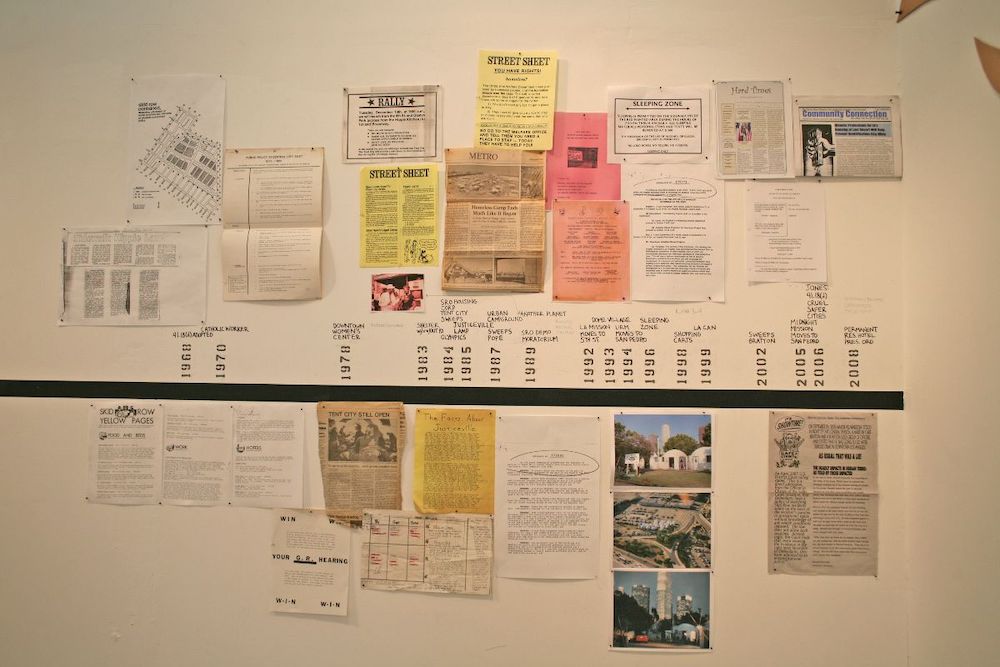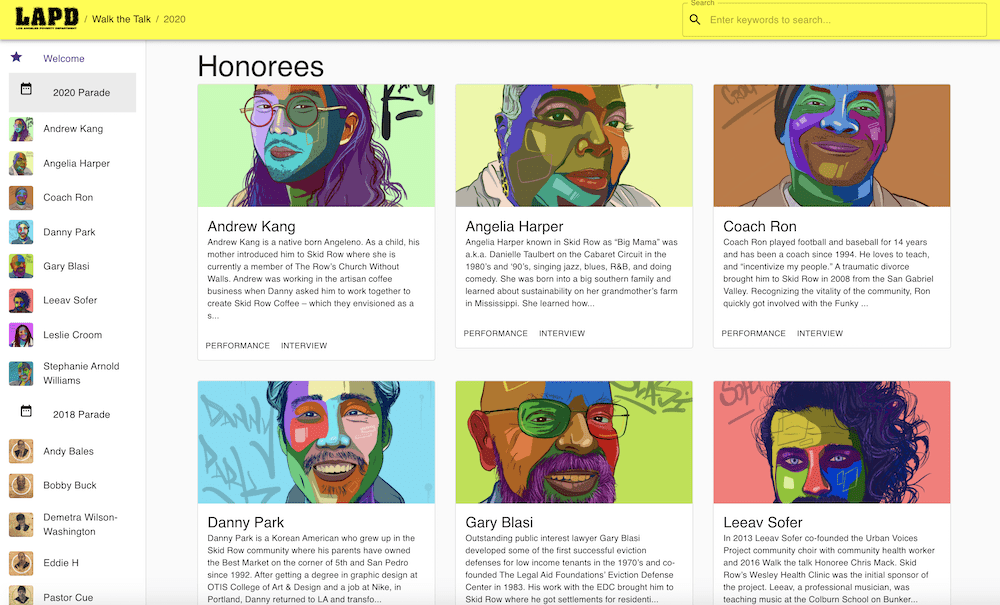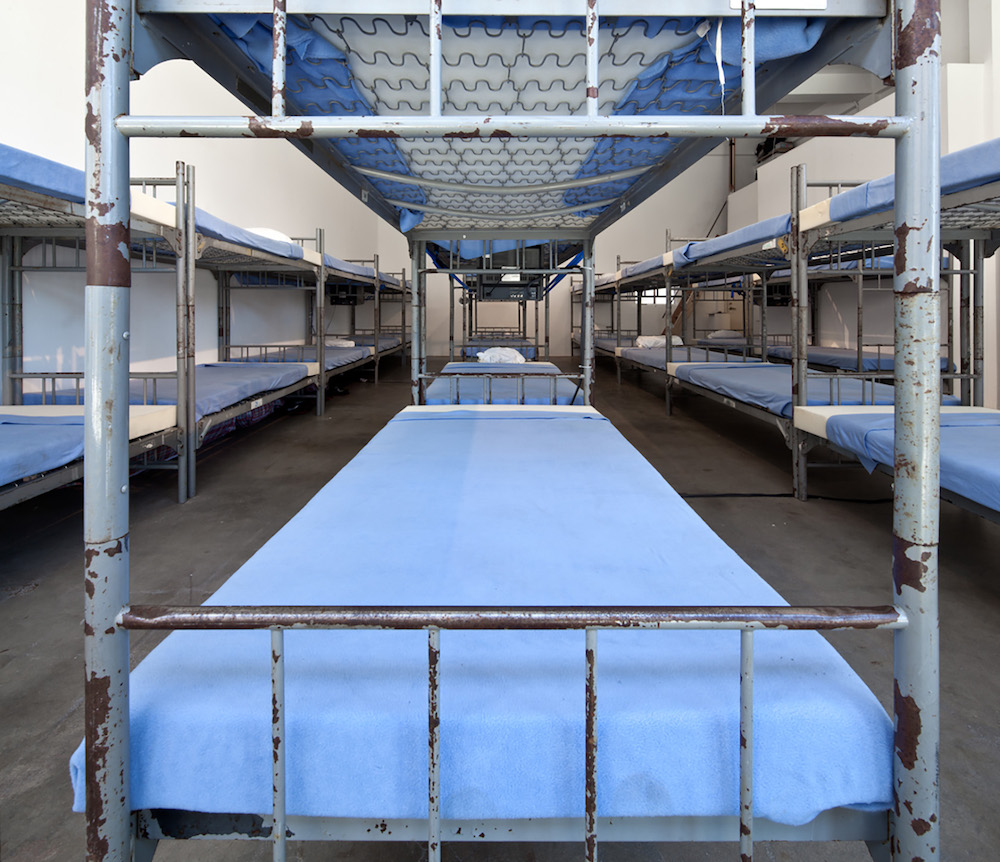The Skid Row neighborhood of Downtown Los Angeles remains emblematic of the city’s ongoing epidemic of housing deprivation. More than 66,400 people were estimated to wake up each morning without stable housing in LA County as of LA Homeless Services Authority’s annual January count—even before the disastrous economic effects of COVID. While city officials call this recent wave a crisis, Angelenos are beginning to wonder if homelessness should be considered endemic to the core functioning of the city, rather than a recent anomaly. The glaring disparity in conditions of life for LA’s wealthy property owners and its impoverished, unhoused residents has been a recurring and increasing “crisis” since the 1980s. In fact, Skid Row has been a focal political flashpoint since the 1930s and remains the site of recurring experiments in urban planning. Yet, such attempts to target or contain city municipal services and social services have failed to provide the most essential need to the working class—housing.

Installation views: Los Angeles Poverty Department’s State of Incarceration, 2010, The Box, Los Angeles. (Images courtesy of The Box gallery e-mail newsletter)
Bordering Skid Row is LA’s acclaimed Arts District, where a period of extreme gentrification ushered in upscale venues, thriving breweries, an influx of wealthy, loft-dwelling homeowners and skyrocketing rents, along with 12 leading commercial art galleries. The convergence of urban gentrification, art production, and LA’s “homeless crisis” in this area starkly illuminates the paradoxes of contemporary art, where radical artistic content is beset by the extractive gallery system. Cashing in on the cultural capital of the “art world” has been integral to developer and real-estate interests that have completely transformed Downtown LA, and brought immense pressure and heightened policing to Skid Row’s unhoused residents.
I spoke with an Arts’ District mainstay, The Box gallery, and a Skid Row performing arts organization, the Los Angeles Poverty Department (also known by its cheeky acronym LAPD), to understand how an art space can bring its unhoused neighbors into the gallery space, physically and virtually.

Installation Images: Skid Row History Museum at The Box, 2008. Images courtesy of LA Poverty Department. (Images courtesy of The Box gallery e-mail newsletter)
Since 1986, LAPD has amplified the voices of Skid Row residents through performances and public art projects that form a counternarrative to the handwringing tragedy-porn espoused by liberals and right-wingers alike about Skid Row and its inhabitants. LAPD’s founder John Malpede was one of the first performance artists to work primarily with homeless actors, writers and participants. The mission is simple, yet profound: to share the concerns, needs, dreams and stories of Skid Row community members, in their own words.
The supportive and experimental relationship between LA Poverty Department and The Box’s founder and curator Mara McCarthy began in 2008 with the “Skid Row History Museum” exhibition at The Box’s former Chinatown location a few miles north of Skid Row, which hosted a flurry of participatory events, performances and musical acts, alongside an exhibition of archival material on Skid Row’s largely untold community history.

Installation Images: Skid Row History Museum at The Box, 2008. Images courtesy of LA Poverty Department. (Images courtesy of The Box gallery e-mail newsletter)
LAPD’s Associate Director Henriette Brouwers fondly remembered the lively crowds when Skid Row came to The Box, with people hanging out of the windows for live performances, and crowds from all walks of life sharing a recognition of Skid Row beyond the dire conditions of American poverty. This vibrant exhibition demonstrated to Brouwers and Malpede the importance of having a physical art space to gather and exchange knowledge and care within the community, for the community.
They went on to create this space in 2015, opening the Skid Row History Museum & Archive, now located at 250 South Broadway. The space hosts performances, exhibitions and the Skid Row History archives, along with numerous ongoing community-led artistic and archival projects.

Installation Images: Skid Row History Museum at The Box, 2008. Images courtesy of LA Poverty Department. (Images courtesy of The Box gallery e-mail newsletter)
Over LA’s lockdown summer of 2020, McCarthy saw an opportunity to highlight her gallery’s history with the LA Poverty Department through a digital campaign for gallery audiences stuck at home. The Box’s email newsletter series shared images and material from the 2010 “State of Incarceration” exhibition and performance series with LAPD that focused on the urgent issue of California’s prison overcrowding. The exhibition filled The Box with large, steel prison beds (paid for by the CBS soap opera, The Bold and the Beautiful in a quintessentially LA moment), where LAPD actors sat and rehearsed scripts developed from their lived experiences in prison. Brouwers recalled the unique interchange that occurred when gallery attendees, unlike the usual theater patrons, observed quietly and patiently. This allowed for a generative silence to develop as they occupied the prison beds together, mimicking the long silences and boredom of life on the “inside”, in a profound moment of non-theatrical performance.

Los Angeles Poverty Department, Walk the Talk parade/performance. Top image photographer: Austin Hines. Bottom image photographer: KCRW’s Avishay Artsy, 2012. Images courtesy of LA Poverty Department. (Images courtesy of The Box gallery e-mail newsletter)
The exploratory projects between The Box gallery and LAPD provide a poignant example of how art spaces can create meaning with their communities. McCarthy reflected on her motivations to defy the social enclosures of the commercial art world by opening her space as a resource to LAPD, in the simple acknowledgment that the Arts District and Skid Row are part of the same Downtown community and need to learn how to act accordingly, and respect each other as neighbors.

Screenshot of LAPoverty Department website, Walk the Talk digital archive. Website created by artist / technologist Rob Ochshorn. Permission granted from The Box gallery. (Images courtesy of The Box gallery e-mail newsletter)
Throughout June and July, @theboxla celebrated the LAPD’s newly digitized “Walk the Talk” Archive, with short video excerpts from the archive’s nearly 70 hours of interviews with local heroes, activists and important figures who lived, worked and sometimes experienced homelessness in the Skid Row community since the 1980s. LAPD’s “Walk the Talk” began in 2008 with plans to create a Skid Row Walk of Fame to publicly hail unsung community leaders of Skid Row, complete with sidewalk plaque-stars mirroring the Hollywood Walk of Fame. They gathered the life stories of chosen local icons from transcribed interviews, which later provided scripts for a series of public performances. Years of bureaucratic barriers evolved the sidewalk project into a bi-annual “Walk the Talk” neighborhood march, inaugurated in 2012 with three days of boisterous marchers filling the streets of Downtown and Skid Row, performing these narratives. The digitization of this archive was finally completed this year by software designer Rob Ochshorn, providing an invaluable resource for a people’s history of Skid Row. The archival interviews capture the ingenuity, grit, and unfathomable strength of daily survival on the streets of Los Angeles, along with the truly affecting grace and wisdom of its dwellers.
The “Walk the Talk” digital archive interview series can be found on the LAPD website (lapovertydept.org) and @LApovertydepartment, and video highlights remain on The Box gallery’s Instagram, @theboxla.


